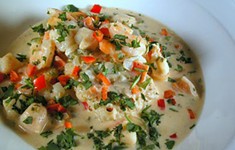
In “A Seafood Industry Giant in the Making,” Rabobank highlights four significant hindrances to Brazil becoming a major force in global seafood production. They are: the considerable bureaucracy and red tape that currently stands in the way of obtaining farming licenses; a lack of bio-safety standards for production; an underdeveloped fish feed industry; and the absence of public information on the sector.
Despite having to overcome such challenges, the outlook for Brazil’s seafood sector is “quite appealing,” suggested the report.
“Brazil’s intrinsic natural resources make it a potential aquaculture powerhouse,” said Rabobank, highlighting that the country has considerable stretches of water and land at its disposable. In addition, its vast grain output has further growth potential and could easily support the production of marine species that consume a vegetarian diet.
The report points out that feed cost advantage was a substantial factor behind the growth of the country’s poultry and pork industries, which are now the second and fourth largest in the world, respectively.
On the demand side, domestic consumption should continue growing “relatively fast” from its current and fairly lowly level of 9.4 kilogram per capita, on the back of the expected rise in income levels, coupled with changes in consumers’ preference toward food quality and healthier products.
Fast-growing domestic consumption is also likely to promote an increase in Brazilian seafood imports as some of the preferred species cannot be grown in Brazil, most notably cod and Atlantic salmon.
In 2011, imports of cod amounted to 43,000 metric tons (MT) while salmon imports stood at 40,000 MT, and Rabobank expects to particularly see a large growth in the latter when the results for 2012 are published.
Salmon’s popularity has been aided by a growing affection for Japanese-style cuisine and restaurants, but the main catalyst was the infectious salmon anaemia (ISA) outbreak in Chile in 2007.
In 2008 and 2009, Chilean salmon farmers had to prematurely harvest large proportions of their biomass because of the disease. As the fish were too small to be sold as fillets in the United States and Europe, large volumes of whole fish were sold on the Brazilian market far below the cost of production. This move served to promote the fish to millions of new consumers, said Rabobank.
“Currently, spurred by low salmon prices, Brazilian demand is set to reach a new record. Chilean exports to Brazil for the first six months of 2012 had increased by 91 percent to a total of 31,000 MT. Due to the high level of protein consumption but still very low salmon consumption per capita, Brazil is seen as a key driver of global salmon demand over the next five years,” according to the report.
Domestically, though, the country’s fish farming growth is still “crawling,” said Rabobank. In 2010, its total seafood production amounted to just 1.26 million MT, of which 70 percent came from wild fisheries. Aquaculture harvests accounted for a modest 479,000 MT that year with finfish species making up 81 percent of the total, followed by shrimp production with 16 percent. Mollusks and frogs accounted for the remainder.
And yet the sector is not without traction, posting an annual growth rate of 8 percent between 2003 and 2010. Furthermore, according to the Brazilian Ministry of Fisheries and Aquaculture, tilapia production has risen at an annual rate of 17 percent during the past four years and topped 155,000 MT in 2010, which made it the sixth largest producing nation in the world.
“At present, it seems tilapia is the most attractive and likely species that Brazil could export,” said Rabobank.
While tilapia is one of the world’s most widely-produced species, there is also an indigenous farmed fish that offers further potential. Tambaqui (Colossoma macropomum) has become increasingly popular, and besides a greater availability in Brazilian supermarkets, the fish is also exported to European markets like Portugal and France.
In 2010, Brazil produced 54,000 MT of tambaqui, an increase of 17 percent on the previous year.
Looking forward, Rabobank analysts believe Brazilian aquaculture production could reach 1 million MT by 2022.
“All in all, Rabobank’s view is that in spite of all the challenges the Brazilian aquaculture sector will have to cope with over the coming years, the country — led by private and government investments — will enlarge its importance in the global aquaculture scenario,” concludes the bank’s report.







